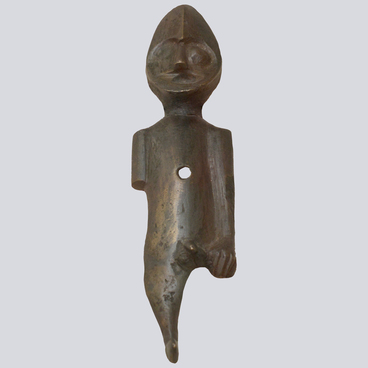Domestication of the horse was one of the most important phases in the history of human civilization. Tamed animals helped their masters cover large distances, carry heavy loads, and plough the ground quickly. So horse breeding became a widespread activity rather soon, even horse-breeding cults appeared with their own rituals and accessories.
Bridle plate
Время создания
8th-4th centuries BC
Размер
3,35x3,73 cm
3.35х3.73х1.57 cm
3.35х3.73х1.57 cm
Техника
bronze, glass. Casting, inlay
Выставка
2
Открыть в приложении#1
Bridle plate
#3
#4
The fact that people decorated saddles, bridles and bits became known due to archeological excavations. Lots of articles made of leather, bone and wood were found by experts in the 4th Murzikha burial ground, where diverse burial accessories were found in good condition.
In 1991, researchers found a facing plate there, dating back to the 8th-6th centuries BC. It used to be part of a decorative set for a horse harness and now it is on display in the museum.
#5
In the centre of a round bronze plate, which was probably decorated with mother-of-pearl, there is a cylindrical insert made of calcite, edged with a gold ring, and topped with a gold star. The space between the gold patterns is filled with coloured glass.
#6
The plate is a cloisonné article (the French word cloisonné means separate). It is an ancient method of compartmental inlays. To make such decorations, craftsmen used thin metal compartments filled with items carved from various materials, such as enamel, mother-of-pearl, stone, or porcelain. Then the surface of the article would be annealed and polished several times to make the ornament as smooth as possible.
The plate on display belongs to the early Iron Age and proves that ancient people already had skills of rather sophisticated and diligent metal treatment. It also proves that in everyday life people used both practical and decorative articles. Experts say such jewelry for domestic animals was not rare in the Volga-Kama region, in fact it was quite often used to decorate reins and other accessories.
#7
Similar accessories have been found in Western Asia, the Northern Caucasus, and Transcaucasia, too. It is proof that the people living there shared trade and cultural ties, which contributed to the emergence and development of new crafts and traditions.
#8
National Museum of the Republic of Tatarstan
читать дальшескрыть
00:00
00:00
1x
Bridle plate
Время создания
8th-4th centuries BC
Размер
3,35x3,73 cm
3.35х3.73х1.57 cm
3.35х3.73х1.57 cm
Техника
bronze, glass. Casting, inlay
Выставка
2
Открыть в приложении
Поделиться



